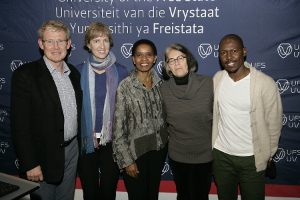
From the left are Prof Lucius Botes, UFS: Dean of the Faculty of the Humanities; Prof Helene Strauss, UFS: Department of English; Prof Pumla Gobodo-Madikizela, UFS: Trauma, Forgiveness and Reconciliation Studies; Prof Antjie Krog, UCT: Department Afrikaans and Dutch; Dr Buhle Zuma, UCT: Department of Psychology. Both Prof Strauss and Dr Zuma are partners in the Mellon Foundation research project. |
“This is one of the bitterest moments I have ever endured. I would rather see my daughter carried away as a corpse than see her raped like this.”
This is one of 32 testimonies that were locked away quietly in 1902. These documents, part of the NC Havenga collection, contain the testimonies of Afrikaner women describing their experiences of sexual assault and rape at the hands of British soldiers during the South African War.
This cluster of affidavits formed the foundation of a public lecture that Prof Antjie Krog delivered at the University of the Free State’s (UFS) Bloemfontein Campus on Tuesday 23 June 2015. The lecture, entitled ‘They Couldn’t Achieve their Goal with Me: Narrating Rape during the South African War’, was the third instalment in the Vice-Chancellor’s Lecture Series on Trauma, Memory, and Representations of the Past. The series is hosted by Prof Pumla Gobodo-Madikizela, Senior Research Professor in Trauma, Forgiveness, and Reconciliation Studies at the UFS, as part of a five-year research project funded by the Andrew W. Mellon Foundation.
Verbalising revulsion
The testimonies were taken down during the last two months of the war, and “some of the women still had marks and bruises on their bodies as evidence,” Prof Krog said. The victims’ words, on the other hand, struggled to express the story their bodies told.
What are the nouns for that which one sees? What words are permissible in front of men? How does one process revulsion verbally? These are the barriers the victims – raised with Victorian reserve – faced while trying to express their trauma, Prof Krog explained.
The collusion of men
When the war ended, there was a massive drive to reconcile the Boers and the British. “Within this process of letting bygones be bygones,” Prof Krog said, “affidavits of severe violations by white men had no place. Through the collusion of men, prioritising reconciliation between two white male hierarchies, these affidavits were shelved, and, finally, had to suffer an embargo.”
“It is only when South Africa accepted a constitution based on equality and safety from violence,” Prof Krog said, “that the various levels of deeply-rooted brutality, violence, and devastation of men against the vulnerable in society seemed to burst like an evil boil into the open, leaving South African aghast in its toxic suppurations. As if, for many decades, we did not know it was there and multiplied.”